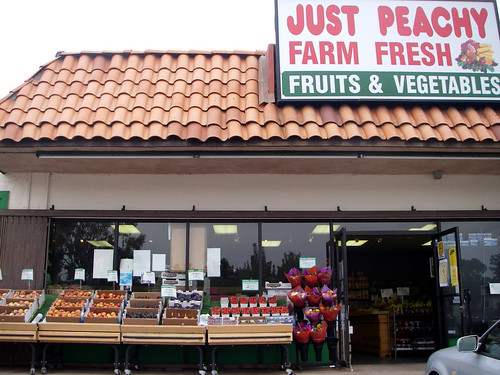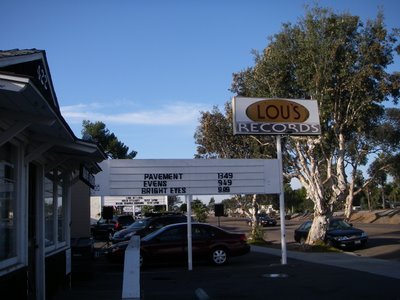

Today is National Buy Local Day. Be sure to get out and enjoy this nice weather and support some of our cool little local mom&pop business. I plan on stopping in Ducky Waddles and Lou's Records myself.
Why Buy Local?
• Local businesses produce more income, jobs, and tax receipts for local communities than big box stores do.
• Local businesses are more likely to utilize local ads, banks and other services.
• Local businesses donate more money to nonprofits and are more accountable to their local communities.
• Supporting local businesses preserves the economic diversity of our communities and the unique character of our neighborhoods.
• Supporting local businesses is good for the environment, because it cuts down on fuel consumption. Buying locally produced goods reduces the need to ship goods from thousands of miles away and also cuts down on the distances shoppers travel.
* And don’t forget to also buy Fair Trade, organic and green!
ON SATURDAY, NOVEMBER 18TH, LET’S BUY LOCAL!
www.buylocalday.org
Surfers, be sure to support your local shapers. Avoid outsourced "pop-outs" from Thailand and China. Thank you.

I go to the farmer's market every Sun if that counts.
ReplyDeleteI like Just Peachy, and like to go to local eateries, like Encinitas Cafe, Roxies, etc.
ReplyDeleteLou's is cool, too. Oh, and I love going to La Paloma, now and then, when something good is showing.
Ok I'll buy from a local dealer
ReplyDeleteTry the arizona exchange undercover narc. so we can read about you in the paper.
ReplyDeleteBuy local. That is easy for you legal residents to say. I have a hard time finding dates for nourishment and dried camel dung for heat. I suppose that will change now that the demos have taken over government. I expect to come out of the short term rentals soon and get accepted with open arms in congress.
ReplyDeleteI'm thinking of a place on Neptune so I can use the new beacons beach access. This will let me bring more and better things over the beach.
I support using more oil and more explosives. Here's to living in funky leucadia. I love America. I just don't like infidels.
New Encinitas railroad crossing proposed
ReplyDeleteBy: ADAM KAYE - Staff Writer
ENCINITAS ---- Councilman Jerome Stocks is proposing to close the hazardous railroad crossing at Leucadia Boulevard and move it about a quarter-mile to the south, at Cadmus Street.
Stocks, the city's delegate to the North County Transit District and chairman of that agency's board, presented his concept informally at a council meeting this month.
He has not presented his plans to the transit district, which owns and operates the railway from the Orange County line to downtown San Diego. The transit district's board must approve the plan.
In interviews last week, Stocks said a crossing at Cadmus would be safer than Leucadia's, where eastbound vehicles must climb a short, steep incline to get up and over the tracks.
The incline is especially dangerous for semitrailers and long, low-carriage vehicles that can get stuck on it.
Councilwoman Maggie Houlihan said Friday she likes the proposal.
"If it works as well as it sounds, hallelujah!" Houlihan said. "It sounds good ---- almost too good to be true ---- and nobody thought of doing that."
The Leucadia 101 MainStreet Association, which represents merchants and property owners along the corridor, has not yet taken a position on the Cadmus plan.
"I like anything that improves the safety," said Patricia Bell, the group's president.
She said she was concerned, however, that closing the Leucadia Boulevard crossing could harm merchants near it. She also worried about losing pedestrian access across the tracks at the boulevard.
Those are among many concerns that would be sorted out during months of public hearings, Stocks said.
Safety, he said, is the driving the proposal.
Since 1980, trains have struck vehicles at the crossing nine times, Federal Railroad Administration records show. Three of the collisions involved semitrailers.
Most recently, in September, a Carlsbad man died from injuries he suffered when a southbound passenger train struck his vehicle. Another fatality occurred at the crossing in 1992.
"The trains don't want to come into contact with anything," Stocks said, "and that intersection has a higher history of contact than others."
At the Leucadia crossing, busy roads sandwich a railroad that carries up to 50 trains a day. To the west is North Coast Highway 101. Footsteps to the east, and up the steep slope, is the railroad. A short distance farther east is Vulcan Avenue.
On average, 13,000 vehicles use the crossing daily, a number projected to increase to 17,000 in 2030.
City engineers have produced a plan that shows:
- a roundabout traffic circle to regulate traffic at what would become a T intersection at Leucadia Boulevard and Vulcan Avenue;
- a five-lane crossing at Cadmus Street, with two westbound left-turn lanes and one westbound right-turn lane onto the highway; two eastbound lanes would direct traffic north and south onto Vulcan Avenue;
- a dedicated left-turn lane for southbound highway traffic onto eastbound Cadmus and a dedicated right-turn lane from the northbound highway onto Cadmus; and,
- dedicated turn lanes from north- and southbound Vulcan onto westbound Cadmus.
City officials say the plan leaves at least two questions unanswered.
Stocks and city engineers said they do not know whether a pedestrian crossing could be retained at Leucadia Boulevard. They also don't know whether the existing traffic signal at Leucadia Boulevard and the coast highway would remain.
What is known, Stocks said, is that the Cadmus plan would not require the condemnation of private property and would cost less than $10 million. That's much cheaper than other options the city has entertained.
In March, a consultant's report concluded that elevating or lowering traffic lanes above or below the railroad with bridges, tunnels or trenches would cost anywhere from $88 million to $160 million.
At the time, officials agreed to pressure the state Public Utilities Commission to allow a cheaper alternative: two one-way streets built at railroad level that would cross the tracks north and south of Leucadia Boulevard.
The plan fell out of favor locally because of a narrow right of way and steep slope north of the boulevard, Stocks said.
Also, the commission opposes new, "at-grade" crossings, and the city envisioned two of them, at Jasper and Europa streets.
Stocks said he hopes the commission would accept an at-grade crossing at Cadmus. He said two of the commission's engineers visited Encinitas earlier this month, and while they didn't give a yes answer to the Cadmus plan, they also didn't reject it outright.
The city must submit formal design plans as part of an application to build the crossing, commission spokeswoman Susan Carothers wrote in an e-mail last week.
At their meeting, the commission's engineers told city officials "they could not take a position," Carothers wrote.
Stocks' tone, however, is more optimistic.
"The PUC (engineers) acknowledged that the current situation at the Leucadia intersection is less than ideal," he said. "That helped. The new concept of just a southerly crossing means they don't have to overcome their internal opposition to a new, at-grade crossing, because we're moving an existing one to make it safer. That's something that's easier for them to sign off on."
The Cadmus crossing offers other attributes, Stocks said.
For starters, the crossing could meet federal requirements for a "quiet zone," he said, which means trains would not need to blow their horns when approaching it.
Computer modeling based on traffic projections for 2030 shows that a Cadmus crossing would improve the flow of traffic. Average peak-hour delays at Leucadia would range from 54 to 103 seconds; at Cadmus, the delays would range from 27 to 35 seconds, the data show.
"I think the concept sounds interesting and obviously worth exploring," said Thomas Frank, the Leucadia representative on the Encinitas Traffic Commission.
If a new crossing would allow for the silencing of train horns, "I see that as being a huge improvement to the Leucadia Highway 101 corridor," he said.
Councilwoman-elect Teresa Barth said Friday that the Leucadia crossing is "a scary place," and "I avoid it all costs." She added that she likes Stocks' suggestion.
"We don't know all of the ramifications, but it's a good start," Barth said.
Stocks said he hopes to bring a refined proposal to the council when it meets in January to set their goals. If endorsed by the council, the city would begin preparing its application to the Public Utilities Commission.
The $19.9 billion in transportation funds created under the recently approved Proposition 1B could help pay for the crossing, Stocks said.
"My goal is to have this plan accepted and funded so it can be built when the approvals are received," he said.
Contact staff writer Adam Kaye at (760) 943-2312 or akaye@nctimes.com. Comment at nctimes.com.
Excellent work Jerome. You are really thinking and acting to solve a long time problem for Encinitas. Please assure that the new crossing will be a quiet zone considering double tracks will bring over 100 trains per day. That’s a big train blast every averaging 14 min. 24 hours everyday if left unchecked.
ReplyDeletePlease Please Please maintain a pedestrian crossing at Leucadia Blvd. considering it is a heavily used pedestrian travel way! Move the one planned for El Portal to Leucadia Blvd. considering the new intersection will be closer to El Portal.
ReplyDeleteI think the NCTD and SANDAG should include another crossing at Leucadia Blvd. The funds should come from Grants trying to promote more Smart Growth area which include Walkable communities.
ReplyDeleteRefresh your browser, I put a new post about the intersection up.
ReplyDelete